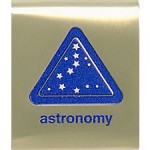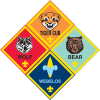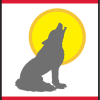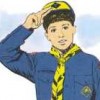Belt Loop
Complete these three requirements
- Demonstrate how to focus a simple telescope or binoculars. (A local astronomy club may be a resource for this activity.)
- Draw a diagram of our solar system — identify the planets and other objects.
- Explain the following terms: planet, star, solar system, galaxy, Milky Way, black hole, red giant, white dwarf, comet, meteor, moon, asteroid, star map and universe.
Academics Pin
Earn the Astronomy belt loop and complete five of the following requirements.
- Draw a diagram of a telescope and explain how it works.
- Explain how to use a star map.
- Draw and label five constellations. See if you can locate any of them in the sky using a star map.
- Find the North Star. Explain its importance.
- With your parent’s or adult partner’s permission, interview an astronomer. This person may be a professional or an amateur astronomer from a local astronomy club. Explain what you learned to your den or family.
- Learn about careers that relate to astronomy. Make a list of those careers. Tell your den or an adult family member what school subjects will help you get a position in those careers.
- Visit a planetarium or a local astronomy club. Give a report on what you learned to your den.
- Make a poster illustrating the different kinds of stars. Include a diagram showing the life cycle of a star.
- Learn about some of the early space missions. Tell your den or family about one of them.
- Find a news story about a recent happening related to space. Tell your den or family about this event.
- Write a report on two famous astronomers.
- Locate three major observatories on a map. Explain why these locations are good for astronomy.
Additional Information
The North Star
Finding the North Start is relatively easy once you find the Big Dipper — one of the easiest constellations to locate. Once you find the North Star you can find the Little Dipper. They won’t always be at the same angle, though — in the course of a year, they will both rotate completely around the North Star.
True North
Draw an imaginary line straight down from the North Star to the ground. This direction is true north, and if you can find a landmark in the distance at this point, you can use it to guide yourself.
Cassiopeia
Locate the North Star (Polaris) in the night sky. The North Star is the last star in the handle of the Little Dipper constellation. If you have trouble finding it, look for the Big Dipper. The two lowest stars in the Big Dipper (the outermost stars of the cup of the dipper) form a straight line that “points” to the North Star (if you imagine the distance between the two lowest stars as being x, the north star will be a distance of 4x away in the direction that the two lowest stars point). You may also find the constellation Cassiopeia, which is always opposite the Big Dipper. The North Star is located about midway between the central star of Cassiopeia and the Big Dipper.
Famous Astronauts
- Sally Ride
- Ellison Onizuka
- John Glenn
- Neil Armstrong
- Yuri Gagarin
- Alan Shepherd
- Buzz Aldrin
Constellations
- Aries—The Ram
- Cancer—The Crab
- Crux—Southern Cross
- Draco—The Dragon
- Gemini—The Twins
- Libra—The Scales
- Orion—The Hunter
- Pegasus—The Winged Horse
- Pisces—The Fish
- Sagittarius—The Archer
- Scorpius—The Scorpion
- Taurus—The Bull
- Ursa Major—The Great Bear
- Ursa Minor—The Lesser Bear
Famous Spacecraft
- Apollo 11
- Apollo 13
- Challenger
- Friendship 7
- International Space Station
- Lunar Lander
- Space Shuttle
- Sputnik
- Telstar
Resources
Check the children’s section at your local library for information on astronomy. If you have access to the the Internet, try using various search engines to 0look for the information you need. (Be sure you have your parent’s or adult partner’s permission first.)
A field trip to an observatory, planetarium, museum, or local astronomy club may provide an excellent experience in astronomy.
Be sure to check out the Space Place; it has lots of fun, astronomy-related activities:
http://spaceplace.jpl.nasa.gov
And don’t miss these good astronomy sites, either!
http://astroleague.org
http://skyandtelescope.com
http://stardate.org






